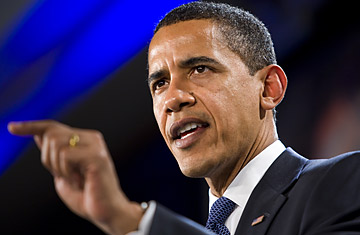
President Barack Obama
(2 of 2)
For years, Presidents have used this image of omnipotence to mask a reality of inaction. The pattern got its start in the early 1970s, when Richard Nixon appointed the nation's first energy czar, a Coloradan named John Love. The arrival of the handsome Westerner was announced with appropriate czarist fanfare, and Love went right to work on a plan to reduce the amount of energy that Americans consumed. But he quickly realized that Nixon didn't really want Americans to consume less energy; he wanted people to think that he cared about the issue, even if he didn't. Love soon quit in frustration.
Love's experience became an enduring model for Washington czars: A large issue grabs the public's attention. The Administration has no solution — no popular one anyway. So the President names a czar. After a day or two of stern talk about crashing through bureaucratic walls and knocking pointy heads together, the czar gradually settles into lonely isolation in the Executive Office building, venturing out to give speeches at interest-group luncheons and perhaps shake hands with the President at a White House Christmas party. (See who's who in Obama's White House.)
Some czars have been famous, like drug czars Bill Bennett and Barry McCaffrey. Others have been obscure, like George W. Bush's "Katrina czar," Donald Powell. Either way, in Washington, the appointment of a czar is often a sign that the government plans to do very little.
Nixon enjoyed the word czar to describe his point people, but over time, Presidents became wary of it. There was no going back, however. Commentators and headline writers loved the term packed so much punch for such a little word.
Czar or no czar, Obama has a genuine crisis boiling up in Detroit. Without major changes in the structure of the industry, the auto business is going to sink under mountainous waves of red ink. GM and Chrysler were in trouble even before the recession tore the bottom out of sales — and Ford's slightly better financial picture has been clouded by nearly $15 billion in losses last year.
Real change won't come easy. Two major players in restructuring the industry — major bondholders and the United Auto Workers (UAW) — have thus far shown little interest in renegotiating their agreements. Union locals in Michigan and New York have rejected proposals for contract concessions, and UAW chief Ron Gettelfinger has sensed the mood of his membership. He's not buying the claim that union costs are sinking the industry. Other labor leaders are watching Obama's reaction to the UAW to see whether the new President will stick up for his union friends. Meanwhile, business continues to tumble. Forecasters predict 2009 sales of 10 million to 11 million units, down by about a third from recent years, when the economy was robust. And until people stop losing their jobs, sales are unlikely to rebound.
A thorny patch of troubles indeed. And one that properly belongs on the President's desk, with help from his duly constituted Cabinet. It's one thing to be a czar in America; it's quite another to be the boss.
